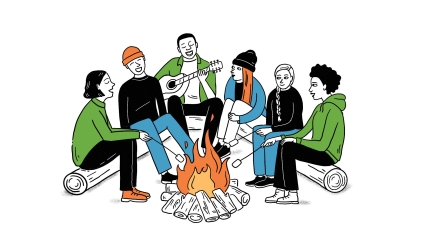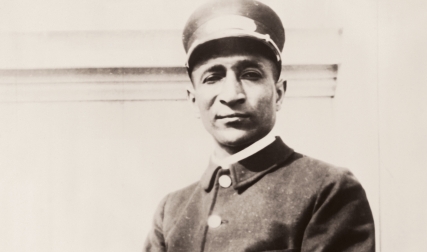More than a decade ago, a Stanford grad student came to an unsettling realization about the growing divisiveness in America. “I started to think about how politics and polarization have encroached into parts of life that are inherently apolitical, how it changes who you want to work with, who you want to date, who you want to spend time with socially,” says Sean Westwood, who earned his master’s and a doctorate in communication research at Stanford in 2014. “That struck me as a fundamental problem with modern society.”
Today Westwood, an associate government professor at Dartmouth, believes polarization has created “a bigger divide in America than race.” Two years ago, with Yphtach Lelkes from Penn and Shanto Iyengar from Stanford, he founded the Polarization Research Lab (PRL) to better understand—and halt—the growth of partisan animosity.
He acknowledges that our differences are nothing new. “Polarization has been so embedded into American identity that it is persistent and relatively stable,” he says. “It moves in the short term in response to major events—conventions, assassination attempts—but it always quickly returns to prior levels.” These days, however, a split electorate seems more divided—and nastier—than ever. So it comes as a surprise that Westwood’s research reveals that we agree more than we think. The states may be red or blue, but most people are more purple than anything.
Westwood has found substantial overlap between Republicans and Democrats on topics such as patriotism and respect for democracy. The lab’s findings echo a 2023 report by the Carnegie Endowment for International Peace, which found that, while American politicians are “highly ideologically polarized,” American voters are not as polarized as they think they are, even on hot-button issues such as abortion, immigration, and gun control. Rather, it is the people at the most partisan edges of the political spectrum—progressive activists on the left and committed conservatives on the right, people who live and breathe politics—who hold the major misconceptions about their differences with the other party. These members of the electorate are whipped up by a small but vocal minority of elected officials.
“Americans are inundated by negativity from their elected officials and form a warped view of the state of American politics,” Westwood explains. “They are learning to hate from the hatred they see from their leaders.”
“Americans are inundated by negativity from their elected officials. They are learning to hate from the hatred they see from their leaders.”
Like diagnosticians seeking the root of a patient’s symptoms, PRL researchers use artificial intelligence to sift through elected officials’ speech in the form of their writings, social media posts, speeches, and comments on TV. The AI ranks members of Congress by the share of their communications that are personal attacks as well as by the percentage of statements the PRL categorizes as bipartisanship, constructive debate, accomplishments, or policy discussion. That data is cross-referenced to datasets that illustrate what tangible accomplishments members of Congress have achieved as lawmakers—and who contributes money to their campaigns.
“Survey data tell us that the public doesn’t want negative politics,” says Westwood. “So, the real question is: If the public doesn’t demand it, why are elected officials being so negative?”
Clicking through the PRL’s online data is an eye-opening experience that helps explain our perceptions of polarization. More than 53 percent of the 535 members of Congress never or very rarely make a personal attack, according to the PRL. As of October, based on nearly 1.7 million statements analyzed since 2022, 18 members of Congress had not insulted anyone, and 286 members had done so in fewer than 1 percent of their communications.
“But we don’t perceive that, right? Because they are not invited to go on CNN or Fox News to talk about how positive and constructive they were in communicating with their constituents in the prior week,” Westwood says. “Instead, we have people who are maximizing their exposure by saying some rather incendiary things and then getting media attention for saying those incendiary things.”
For example, U.S. Rep. Marjorie Taylor Greene, a Georgia Republican, ranked second in Congress for speech that consisted of personal attacks. More than 13 percent of her floor speeches, press releases, newsletters, and tweets analyzed by the PRL were personal attacks, trailing only Republican Rep. Lance Gooden of Texas at 18 percent. The top Democrat for personal attacks, Rep. Eric Swalwell of California, was slightly behind Greene at 10 percent, followed by Democratic Rep. Robert Garcia of California at just under 8 percent.
Amplified by the media and social media, the vitriol distorts Americans’ views of the other side. One key measure is affective polarization—which describes the difference between how voters rate the party they belong to and their feelings about the other party. An affective polarization rating above 50 percent is what the PRL defines as “very polarized.” As the party conventions ended this summer, America’s affective polarization score was 56 percent. In individual states, affective polarization ranged from a high of 61.4 percent in Maine to a low of 49.4 percent in Utah. Democrats and Republicans are almost equally polarized, according to PRL data.
Although Greene fares much better than the average member of the House in terms of fundraising, only about 11 percent of her donations come from constituents in Georgia. Much of her support comes instead from out-of-state donors in Florida, Texas, and California. And Greene, like other politicians whom Westwood calls “conflict entrepreneurs,” gets little legislation passed.
“The results show something that’s quite striking and disappointing, which is that negativity gets the media attention, but it doesn’t help with fundraising. It doesn’t help with passing legislation. It doesn’t build trust with voters,” Westwood says. “So the most negative representatives, the most negative politicians, have traded off policy advocacy for media coverage. It’s quite clear when you look at the data.”
Negativity isn’t inherently bad for democracy, he contends: It’s necessary as voters with opposing views need to critique the policies and ideas of the other side in hopes of arriving at a place where the best outcome wins. “It’s important to point out bad policy,” he says. “You should be able to use very strong language to call a bad policy bad.” The problem arises, according to Westwood and his coauthors, when politicians believe that insults hurled at the other side will get them on TV, boost their campaign coffers, and put them on a fast track to higher office, no matter how much divisiveness they cause.

Following the July assassination attempt on Donald Trump, some experts predicted a surge of partisan violence. But the PRL found little change in Americans’ support of “violence to achieve a political goal” just days after the shooting. The event did not increase tensions “or support for retaliatory violence in the immediate aftermath,” Westwood and his colleagues wrote. On the contrary, Republicans, including the MAGA branch, became significantly less supportive of partisan violence against Democrats.
“The assassination paper is fascinating,” says Justin Grimmer, a Stanford public policy professor and senior fellow at the conservative Hoover Institution who is a long-time collaborator with Westwood. (Grimmer did not work on the assassination paper and is not part of the PRL). “It’s sort of like a peak Sean Westwood-style paper,” he says. “Timely. He’s running this amazing survey, and he’s able to get it done very quickly.” Grimmer describes Westwood as a rare combination of a researcher with great computer skills and comfort with the latest AI who also has a down-to-earth ability to effectively frame survey questions for regular Americans. “I think he’s the best survey researcher in America,” Grimmer says.
Westwood earned his bachelor’s in political science at the University of Nevada and his first master’s, in new media and society, from the London School of Economics. He grew up in what he describes as a lower- middle-class family in Sparks, Nevada, just outside of Reno. His father worked as a grocery store cashier. His mother was a substitute teacher. “I am not sure if this has influenced how I conduct research,” he says, “but it certainly gives me a very different perspective from many of my fellow professors.”
He tells students in his political polarization course description that they will “grapple with evidence that suggests partisan bias has grown to replace race as the largest divide in American society.” Brian Zheng ’24, now a second lieutenant in the Army, took the course in 2021. “After that, I was pretty much all in on the idea that I wanted to study democracy and partisan American democracy,” says Zheng, who worked with Westwood on his research.
Westwood recently received a grant from the College’s Neukom Institute for Computational Science, which, combined with funding from the Carnegie Corp., will allow the PRL to hire and train Dartmouth undergrads to collect and analyze data from elected officials in all 50 states. That will enable the lab to expand its AI-driven analysis of politicians’ speech to the more than 7,000 elected officials at the state level. Looking at state-level data “will allow us to understand the trajectory of political conflict in this country, because many elected officials start at statehouses,” Westwood
says. “It gives us kind of a lens into the future of representation.”
That future, he believes, is one where politicians always will—and should—disagree. It is how they disagree that Westwood hopes his research will help change. “I’m very optimistic about the future of democracy in this country,” he says. “We went through an administration that many thought would end democracy, but we’ve learned that the bureaucracy is very robust. The courts are very robust. There are many reasons to be concerned about democracy, but I am still bullish on America.”
MIKE SWIFT writes about law and technology.




